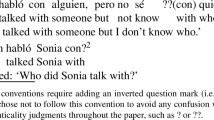Abstract
Sloppy identity under ellipsis is generally attributed to the pronoun in ellipsis being a bound variable. However, sloppy identity can be licensed in structural configurations in which variable binding is ordinarily blocked. This paper provides a solution for this mismatch by reanalyzing the pronouns with the unexpected sloppy readings as E-type pronouns. Under the proposed analysis, the distribution of such pronouns is correctly predicted. It will also be shown that the analysis is successfully extended to sloppy identity in association-with-focus cases.
Similar content being viewed by others
REFERENCES
Belletti, A. and L. Rizzi: 1988, ‘Psych Verbs and ?-Theory’, Natural Language & Linguistic Theory 6, 291–352.
Berman, S.: 1987, ‘Situation-Based Semantics for Adverbs of Quantification’, in J. Blevin and A. Vainikka (eds.), University of Massachusetts Occasional Papers 12, GLSA, pp. 45–68, University of Massachusetts at Amherst.
Chomsky, N. and H. Lasnik: 1993, ‘The Theory of Principles and Parameters’, in J. Jacobs, A. von Stechow, W. Sternefeld, and T. Vennemann (eds.), Syntax: An International Handbook of Contemporary Research, pp. 506–569, de Gruyter, Berlin.
Cooper, R.: 1979, ‘The Interpretation of Pronouns’, in F. Heny and H. Schnelle (eds.), Syntax and Semantics 10: Selection from the Third Groningen Round Table, pp. 61–92, Academic Press, New York.
Dalrymple, M., S. Shieber, and F. Pereira: 1991, ‘Ellipsis and Higher-Order Unification’, Linguistics and Philosophy 14, 399–452.
Evans, G.: 1977, ‘Pronouns, Quantifiers, and Relative Clauses’, Canadian Journal of Philosophy 7, 467–536.
Evans, G.: 1980, ‘Pronouns’, Linguistic Inquiry 11, 337–362.
Fiengo, R. and R. May: 1994, Indices and Identity, MIT Press, Cambridge, Mass.
Geach, P. T.: 1962, Reference and Generality, Cornell University Press, Ithaca, NY.
Hardt, D.: 1993, Verb Phrase Ellipsis: Form, Meaning, and Processing, PhD dissertation, University of Pennsylvania.
Heim, I.: 1982, The Semantics of Definite and Indefinite Noun Phrases, PhD dissertation, University of Massachusetts at Amherst.
Heim, Irene: 1990, ‘E-type Pronoun and Donkey Anaphora’, Linguistics and Philosophy 13, 137–177.
Heim, I.: 1997, ‘Predicates or Formulas? Evidence from Ellipsis’, in A. Rawson and E. Cho (eds.), Proceedings of SALT VII, CLC Publications, pp. 179–211, Cornell University.
Heim, I. and A. Kratzer: 1998, Semantics in Generative Grammar, Blackwell, Oxford.
Hirschberg, J. and G. Ward: 1991, ‘Accent and Bound Anaphora’, Cognitive Linguistics 2(2), 101–121.
Johnson, K.: 1997, ‘When a Verb Phrase Goes Missing’, GLOT 2(5), 3–9.
Kadmon, N.: 1988, On Unique and Non-Unique Reference and Asymmetric Quantification, PhD dissertation, University of Massachusetts at Amherst.
Kratzer, A.: 1989, ‘An Investigation of the Lumps of Thought’, Linguistics and Philosophy 12, 607–653.
Kratzer, A.: 1991, ‘The Representation of Focus’, in A. van Stechow & D. Wunderlich (eds.), Semantics/Semantik: An International Handbook of Contemporary Research, pp. 804–825, de Gruyter, Berlin.
Larson, R. and G. Segal: 1995, Knowledge of Meaning, MIT Press, Cambridge, Mass.
Lasnik, H.: 1976, ‘Remarks on Coreference’, Linguistic Analysis 2, 1–22.
Loebek, A.: 1986, Syntactic Constraints on VP Anaphora, PhD dissertation, University of Washington.
May, R.: 1985, Logical Form, MIT Press, Cambridge, Mass.
Neale, S.: 1990, Descriptions, MIT Press, Cambridge, Mass.
Parsons, T.: 1977, ‘Pronouns as Paraphrases’, ms., University of Massachusetts at Amherst.
Partee, B.: 1973, ‘Some Transformational Extensions of Montague Grammar’, Journal of Philosophical Logic 2, 509–534.
Pesetsky, D.: 1987, ‘Binding Problems with Experiencer Verbs’, Linguistic Inquiry 18, 126–140.
Postal, P.: 1970, ‘On the Surface Verb “Remind”’, Linguistic Inquiry 1(1), 37–120.
Reinhart, T.: 1983, Anaphora and Semantic Interpretation, Croom Helm, London.
Rooth, M.: 1985, Association with Focus, PhD dissertation, University of Massachusetts at Amherst.
Rooth, M.: 1992a, ‘A Theory of Focus Interpretation’, Natural Language Semantics 1, 75–116.
Rooth, M.: 1992b, ‘Ellipsis Redundancy and Reduction Redundancy’, in S. Berman and A. Hestvik (eds.), Proceedings of the Stuttgart Workshop on Ellipsis, Universität Stuttgart.
Rooth, M.: 1996, ‘Focus’, in S. Lappin (ed.), The Handbook of Contemporary Semantic Theory, pp. 271–298, Blackwell, Oxford.
Ross, J.: 1967, Constraints on Variables in Syntax, PhD dissertation, MIT.
Sag, I.: 1976, Deletion and Logical Form, PhD dissertation, MIT.
Stone, M.: 1992, ‘Or and Anaphora’, in C. Barker and D. Dowty (eds.), Proceedings of SALT 2, The Ohio State University, Columbus.
Tomioka, S: 1997, Focusing Effects and NP Interpretation in VP Ellipsis, PhD dissertation, University of Massachusetts at Amherst.
Wescoat, M: 1989, ‘Sloppy Readings with Embedded Antecedents’, ms., Stanford University.
Williams, E.: 1977, ‘Discourse and Logical Form’, Linguistic Inquiry 8(1) 101–139.
Author information
Authors and Affiliations
Rights and permissions
About this article
Cite this article
Tomioka, S. A SLOPPY IDENTITY PUZZLE. Natural Language Semantics 7, 217–241 (1999). https://doi.org/10.1023/A:1008309217917
Issue Date:
DOI: https://doi.org/10.1023/A:1008309217917




